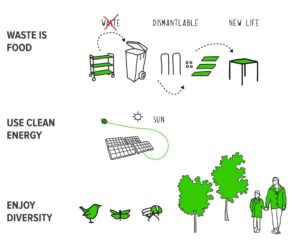Cradle-To-Cradle
CIRCULAR ECONOMY IN BUILDINGS

Image source: City Hall Venlo
Introduction
Energy efficiency is crucial to achieve the EU’s climate goals, but it is also important to improve the efficiency of our waste management at home and in buildings. The so-called cradle-to-cradle (C2C) concept is an innovative approach in this topic focusing on zero waste. Only a few buildings have been built with C2C approach due to its relatively high investment costs, however, this type of buildings have numerous benefits.
Description
The principle of C2C concept is that all materials can be recycled, reused or composted, thus, life cycle of products is in the centre of this innovative approach. The goal of C2C is to build such buildings which use environmentally friendly materials, and thus, produce zero waste.
The Dutch city, Venlo was committed to build a C2C municipal building which embodies the city’s vision in 2007, but the implementation took almost a decade. The building is used by the municipality, businesses, and citizens as well providing them a pleasant and healthy environment. In addition, the return on investment is favourable according to the calculations.
The City Hall Venlo exploits water by collecting and using rainwater, makes energy by solar panels collectors, and a solar chimney, while they also use geothermal energy for heating. It purifies the air via a greenhouse which also generates heat, etc. Green facade produces oxygen, cleans indoor and outdoor air, has a good insulation quality, and provides habitat for smaller animals like birds.
With a special sort of reed bed, we can reach several benefits. In the City Hall Venlo, it not only creates a green environment for people and animals, and cleans the air, but it also purifies rainwater and wastewater of the building, and reduces the effects of heat stress locally.

Main Features
- Sustainability
- Closed loop life cycle
- Energy independency
- Biological and technology cycle
- Consumer awareness
- Eco-friendliness

Advantages and challenges
+ C2C technology results lower operation cost.
+ C2C buildings can contribute to increased biodiversity in the urban areas.
+ Independent from fossil energy sources. In addition, it produces more energy than needed.
+ By providing a healthier working environment, we can expect less sick leave.
+ It improves the quality of water and air.
+ Only C2C certified materials and products are used.
+ C2C buildings form the city’s image.
+ We can monitor the building’s performance continuously.
+ C2C buildings have positive effects for the people, the planet, and the economy.
– High investments costs while the maintenance costs can also be higher.
– Lack of professionals who have the relevant knowledge and experience to plan such buildings.
– As of today, we cannot build a 100% C2C building, thus, stakeholders have to set the main objectives in advance.
– Difficult to find reliable suppliers due to the high standards.

